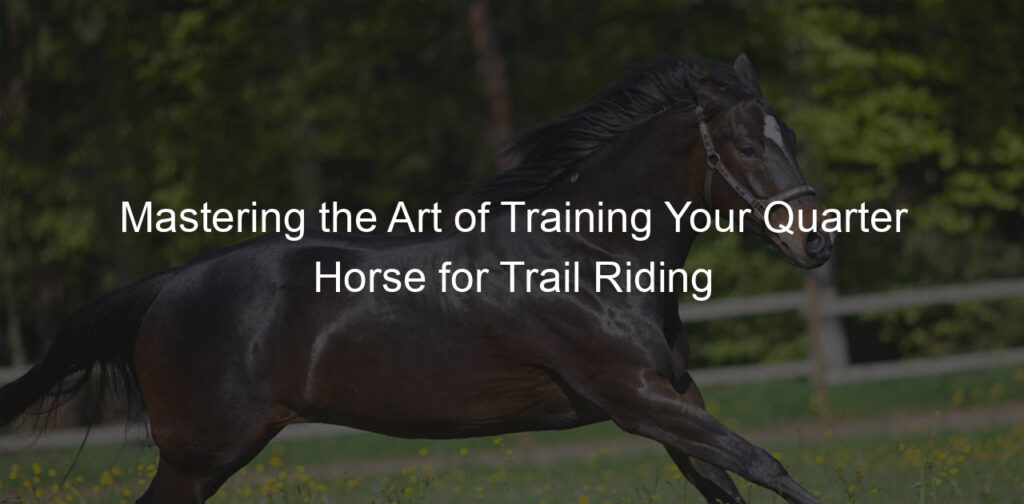Introduction to Quarter Horse Training for Trail Riding
Hey there, horse lovers! Today, we’re going to dive into the exciting world of Quarter Horse training for trail riding. Whether you’re a seasoned equestrian or a newbie horse enthusiast, this guide will give you a good grasp of what it takes to train a Quarter Horse for trail riding. So, saddle up and let’s get started!
- Understanding the importance of training your Quarter Horse for trail riding
- Key benefits of trail riding training
Training your Quarter Horse for trail riding is not just about teaching them how to walk, trot, or canter. It’s about building a strong bond with your horse, understanding their needs, and ensuring their safety on the trail. It’s also about enhancing their physical fitness and mental agility. Plus, it’s a fun and rewarding experience for both you and your horse!
Trail riding training offers a plethora of benefits for your Quarter Horse. It helps improve their balance and coordination, strengthens their muscles, and boosts their confidence. It also exposes them to different environments, which can help them become more adaptable and resilient. And let’s not forget, it’s a great way for you and your horse to enjoy the great outdoors and explore new trails together!
Now that we’ve covered the basics, let’s delve deeper into the world of Quarter Horse training for trail riding. Stay tuned for more insights, tips, and tricks to make your trail riding experience a memorable one. Happy trail riding!
Understanding Quarter Horses: A Breed Overview
Let’s dive into the world of Quarter Horses, a breed known for its speed, strength, and friendly demeanor. Understanding these horses can help us appreciate their unique qualities and why they’re a top choice for trail riding.
Characteristics of Quarter Horses
Every horse breed is unique, and Quarter Horses are no exception. They have distinct physical traits and a temperament that sets them apart. Let’s explore these characteristics:
- Physical Traits
- Temperament
Quarter Horses are medium-sized, typically standing between 14 and 16 hands high (a ‘hand’ is a unit of measurement in the equestrian world, equal to about 4 inches). They have a broad chest and powerful, muscular hindquarters, which contribute to their impressive speed and agility. Their coat comes in a variety of colors, including bay, black, brown, chestnut, dun, red dun, gray, grullo, palomino, red roan, blue roan, and white. Their heads are finely chiseled with a flat profile, wide forehead, and intelligent, alert eyes. Learn more about their physical traits on Wikipedia.
Quarter Horses are known for their calm and steady temperament. They are intelligent, eager to please, and easy to train, making them a popular choice for both novice and experienced riders. They are also known for their bravery and versatility, excelling in a variety of equestrian disciplines. Despite their speed and strength, they are generally gentle and good-natured, making them excellent companions.
Understanding the characteristics of Quarter Horses can help us appreciate why they are so beloved by equestrians worldwide. Their unique combination of physical strength, speed, and gentle temperament makes them a joy to ride and train, whether on the trail or in the arena.
Why Quarter Horses are Ideal for Trail Riding
When it comes to trail riding, not all horse breeds are created equal. Some shine brighter than others, and one such breed is the Quarter Horse. Let’s explore why these horses are a top pick for trail riding.
- Adaptability to different terrains
- Stamina and endurance
Quarter Horses are known for their adaptability. They can handle a variety of terrains, from rocky hills to sandy beaches. This is because of their powerful hindquarters and compact size, which allow them to navigate tricky paths with ease. So, whether you’re planning a ride through a forest trail or a mountain path, a Quarter Horse can handle it. Wikipedia provides more information on their adaptability.
Another reason why Quarter Horses are perfect for trail riding is their impressive stamina and endurance. They were originally bred for working long hours on ranches, which means they have the energy to keep going even on long rides. They don’t tire easily and can maintain a steady pace, making your ride smooth and enjoyable. For more details on their endurance, you can check out this Wikipedia page.
In conclusion, if you’re looking for a horse that can handle different terrains and has the stamina for long rides, a Quarter Horse is an excellent choice. They’re not just adaptable and enduring; they’re also friendly and easy to train, making them perfect for both beginner and experienced riders.
Essential Horse Riding Techniques for Trail Riding
Hey there, horse lovers! Today we’re going to talk about some basic horse riding techniques that are super important when you’re out on the trail with your Quarter Horse. Let’s get started!
Basic Horse Riding Techniques
Before we hit the trail, we need to master the basics. So, let’s start with the two most fundamental skills: mounting and dismounting, and controlling speed and direction.
- Mounting and Dismounting
- Controlling Speed and Direction
Mounting and dismounting might seem simple, but doing it correctly is crucial for your safety and the horse’s comfort. Always approach your horse from the left side, also known as the “near side”. To mount, place your left foot in the stirrup and swing your right leg over the horse’s back. When dismounting, it’s just the reverse. Remember, always be gentle and slow to avoid startling your horse. For more detailed instructions, check out this Wikipedia article.
Controlling your horse’s speed and direction is all about communication. Your hands, legs, and voice all play a part. To speed up, gently squeeze your horse’s sides with your legs. To slow down, sit deep in the saddle and pull back slightly on the reins. Turning is a matter of shifting your weight and using the reins to guide your horse. Remember, it’s not about force, but about building a mutual understanding with your horse. Practice makes perfect!
Mastering these basic techniques is the first step to becoming a confident and competent trail rider. So, take your time, practice, and most importantly, enjoy the journey!
Advanced Horse Riding Techniques for Trails
Hey there, trail riders! Let’s dive into some advanced techniques that will make your Quarter Horse trail riding experience even better. We’re going to talk about two key skills: navigating obstacles and riding on uneven terrain.
- Navigating Obstacles
- Riding on Uneven Terrain
When you’re out on the trail, you’re bound to come across some obstacles. It could be a fallen tree, a stream, or a rocky patch. The key to navigating these obstacles is to stay calm and trust your horse. Remember, your Quarter Horse is a natural at this!
First, approach the obstacle slowly and at an angle. This gives your horse a good view of what’s ahead. Then, give your horse a gentle cue to move forward. Keep your body relaxed and centered. If your horse hesitates, be patient. It’s okay to take a moment to let your horse assess the situation. Once your horse is ready, encourage them to move forward with a gentle squeeze of your legs.
Trails aren’t always smooth and flat. Sometimes, you’ll have to navigate hills, slopes, and uneven ground. This can be a bit tricky, but don’t worry, we’ve got some tips to help you out.
When going uphill, lean forward slightly to help your horse balance. Keep your reins loose to allow your horse to stretch their neck and find their footing. On the other hand, when you’re going downhill, lean back a bit and keep your reins shorter. This helps you stay balanced and gives your horse more control.
Remember, practice makes perfect. The more you ride on uneven terrain, the better you and your horse will get at it. So, don’t shy away from those hills and slopes!
Mastering these advanced techniques will make your trail rides more fun and safe. So, saddle up and hit the trails with your Quarter Horse. Happy riding!
Training Horses for Trails: A Comprehensive Guide
Trail riding is an exciting adventure for both you and your Quarter Horse. But before you hit the trails, it’s important to ensure your horse is properly trained. Let’s start with the basics!
Starting with Basic Training
Before you can ride your Quarter Horse on trails, you need to start with some basic training. This will help your horse become more comfortable and confident, making your trail rides safer and more enjoyable. Here are two key areas to focus on:
- Groundwork Training
- Desensitization Training
Groundwork is the foundation of all horse training. It involves teaching your horse to respond to your cues while you’re on the ground. This can include everything from leading and lunging to more advanced exercises like side-passing and backing up. Groundwork helps to establish respect and trust between you and your horse, making further training easier.
Desensitization training is all about helping your horse stay calm in different situations. This involves gradually exposing your horse to various objects, sounds, and experiences that they might encounter on the trail. The goal is to help your horse learn to stay calm and relaxed, even when they encounter something new or scary. This is crucial for trail riding, as you never know what you might come across on the trail.
Remember, training a horse is a gradual process. It’s important to be patient and consistent, and to always end each training session on a positive note. With time and practice, your Quarter Horse will be ready to hit the trails with confidence!
Advanced Trail Training Techniques
Hey there, horse lovers! Let’s dive into some advanced trail training techniques for your Quarter Horse. These techniques will help your horse become a pro at navigating tricky trails. Ready? Let’s saddle up!
- Training for Water Crossings
Water crossings can be a bit scary for horses at first. But with patience and practice, your Quarter Horse can learn to cross water with confidence. Here’s how:
- Start by leading your horse to a shallow puddle or stream. Let them sniff and explore the water. Remember, curiosity is a good thing!
- Encourage your horse to step into the water by offering a treat or a gentle pat. Never force them in.
- Once they’re comfortable with shallow water, gradually introduce them to deeper water. Always make sure to praise and reward them for their bravery.
Remember, every horse learns at their own pace. So, take your time and make it a positive experience for your horse. Here’s a great resource to learn more about horse training techniques.
- Training for Steep Inclines and Declines
Steep hills can be a challenge on the trail. But don’t worry, your Quarter Horse can handle it! Here are some tips to help them master inclines and declines:
- Start on a gentle slope. Walk your horse up and down the hill, allowing them to find their balance.
- Gradually increase the steepness of the hill. Always stay calm and confident to reassure your horse.
- When going downhill, lean back slightly to counterbalance your horse’s weight. This helps them maintain their footing.
With these techniques, your Quarter Horse will be a trail champion in no time! Remember, practice makes perfect. So, keep at it and enjoy the journey. Happy trail riding!
Quarter Horse Trail Riding: Practical Tips and Tricks
Trail riding is a fantastic way to bond with your Quarter Horse and enjoy the great outdoors. But before you saddle up, there are a few things you need to know to ensure a safe and enjoyable ride. Here are some practical tips and tricks for Quarter Horse trail riding.
-
Preparing Your Horse for the Trail
Before you hit the trail, it’s essential to prepare your horse properly. This includes both physical and mental preparation.
Physical preparation involves ensuring your horse is in good health and fit enough for the ride. Regular exercise and a balanced diet are key. It’s also important to check your horse’s hooves and make sure their shoes are in good condition. A horse with sore feet won’t enjoy the trail!
Mental preparation is all about training. Your horse should be comfortable with the basic commands and be able to handle different terrains and obstacles. Remember, patience and consistency are key when training your horse.
-
Ensuring Safety During Trail Rides
Safety should always be your top priority when trail riding. Here are a few tips to help ensure a safe ride:
- Wear a helmet: A riding helmet can protect you from serious injury in case of a fall. Make sure it fits properly and is approved for equestrian use.
- Check the weather: Always check the weather forecast before you go. Avoid riding in extreme weather conditions.
- Know the trail: Familiarize yourself with the trail before you go. Know where you’re going and what to expect.
- Carry a first-aid kit: Always carry a basic first-aid kit for both you and your horse. It should include bandages, antiseptic wipes, tweezers, and a multi-tool.
- Stay alert: Pay attention to your surroundings and your horse’s behavior. If your horse seems nervous or uncomfortable, it’s best to turn back.
Trail riding with your Quarter Horse can be a fun and rewarding experience. With the right preparation and safety measures, you can enjoy the trail and create lasting memories with your horse. Happy riding!
Equestrian Trail Training: Case Studies
Let’s take a closer look at two real-life examples of Quarter Horse trail training. These case studies will provide you with practical insights and tips to help you train your horse effectively for trail riding.
- Case study 1: Successful trail training techniques
- Case study 2: Overcoming training challenges
Meet Bella, a spirited Quarter Horse mare. Bella’s owner, John, used a combination of groundwork and riding exercises to prepare her for trail riding. He focused on building Bella’s confidence and trust, which are crucial for a successful trail ride.
John started with groundwork, teaching Bella to respond to his cues and commands. He used a lead rope and halter to guide her through various obstacles, like poles and cones. This helped Bella to develop her balance and coordination.
Once Bella was comfortable with the groundwork, John started riding exercises. He began with short rides around the barn, gradually increasing the distance and complexity of the trails. Bella quickly adapted to the new challenges, showing her natural agility and intelligence.
John’s patient and consistent approach paid off. Bella is now a confident trail horse, ready to tackle any trail with ease. You can read more about Bella’s training journey here.
Next, let’s look at Max, a young Quarter Horse gelding. Max’s training journey was a bit more challenging. He was nervous and skittish, especially when faced with unfamiliar situations on the trail.
Max’s trainer, Sarah, used a variety of techniques to help him overcome his fears. She introduced new objects and sounds gradually, allowing Max to explore and get used to them at his own pace. She also used positive reinforcement, rewarding Max with treats and praise when he behaved calmly.
Despite the challenges, Sarah remained patient and persistent. She understood that building Max’s confidence would take time. And her efforts paid off. Max is now a brave and reliable trail horse, ready to take on any adventure. You can learn more about Max’s transformation here.
These case studies show that with patience, consistency, and the right techniques, you can train your Quarter Horse for successful trail riding. Remember, every horse is unique, so it’s important to tailor your training approach to your horse’s needs and personality.
Conclusion: The Joy of Horseback Riding Training
As we wrap up this informative journey, let’s take a moment to reflect on the joy and fulfillment that comes with horseback riding training, especially with the majestic Quarter Horse. The bond you form, the skills you learn, and the adventures you embark on are truly unmatched.
- Recap of key takeaways
- The rewarding journey of training your Quarter Horse for trail rides
Throughout this blog post, we’ve explored the unique characteristics of the Quarter Horse, essential horse riding techniques for trail riding, and comprehensive guides on training horses for trails. We’ve shared practical tips and tricks for Quarter Horse trail riding and highlighted inspiring case studies. Remember, patience, consistency, and understanding are key in training your horse for trail rides.
Training your Quarter Horse for trail rides is a rewarding journey that goes beyond mastering techniques. It’s about building a bond of trust and understanding with your horse. It’s about watching your horse grow and learn, and feeling a sense of accomplishment as you both conquer new trails together. The joy of horseback riding training is in the journey, not just the destination.
As you continue your equestrian journey, remember the words of famous horse trainer, Monty Roberts, “A good horse trainer can get a horse to do what he wants him to do. A great trainer can get a horse to want to do it.” Happy trail riding!









